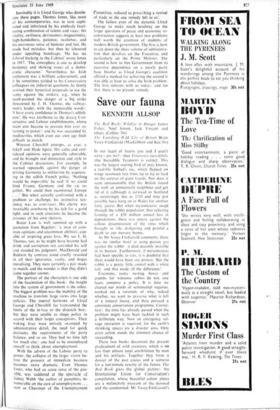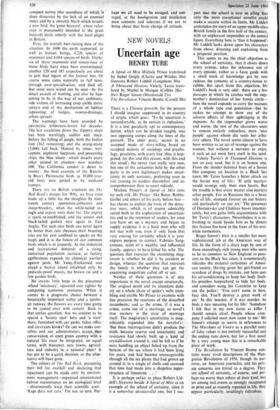Save our fauna
KENNETH ALLSOP
The Red Book: Wildlife in Danger Janie'. Fisher, Noel Simon, Jack Vincent and others (Collins 70s) The Vanishing Wild .Life of Britain Brian Vesey-FitzGerald (MacGibbon and Kee 36s) in our heart of hearts you and I aren't sorry—are we?—that Teratornis incredibili.v (the Incredible Teratornl is extinct. This was the largest soaring bird of prey known, a real-life Sinbad's roc, which flapped on wings seventeen feet from tip to tip to feed on the corpses of giant lizards. Nor does it seem unreasonable that the British found the wolf an unmannerly neighbour and got rid of it (although it survived in Scotland as surprisingly late as 1743 and may just possibly have hung on in Wales for another forty years). But when myxomatosis swept through the rabbit population, thus relieving farming of a £50 million annual loss in depredations, there was outcry against the callous dissemination of the virus which brought so vile, disfiguring and painful a death to our nursery bunny.
As Mr Vesey-FitzGerald comments, there was no similar howl at using poison gas against the rabbit---it died decently invisible in its burrow. Furthermore, if myxomatosis had been specific to rats, it is doubtful that there would have been any protest. 'But the rabbit is a pretty little animal with a white tail: and that made all the difference.'
Coconuts, rustic nesting boxes and crumbs for winsome robins do not, one fears, compose a policy. It is time we cleared our minds of sentimental vagaries, worked out a rationale of why, indeed whether, we want to preserve what is left of a natural fauna, and then pursued a consistent conservation programme. Correc- tion: the time has already passed when the problem might have been tackled in such a deliberate way. Now an emergency sal- vage operation is required, for the earth's shrinking spaces are a disaster area. Only crisis action stands the slimmest chance of succeeding.
These two books document the present predicament of wild creatures, which is no less than almost total annihilation by man and his artifacts. Together they form a dossier of the past causes and a scenario for a last-minute rewrite of the future. The Red Book gives the global picture: the International Union for Conservation's compilation, whose beautiful colour plates are a melancholy museum of the damned and the condemned. Mr Vesey-FitzGerald's
compact survey (the soundness of which is done disservice by the lack of an essential index and by a slovenly blurb which invents a new bird, the 'great buzzard', where refer- ence is presumably intended to the great bustard) deals soberly with the local plight in Britain.
First, the overall, hair-raising data of the situation. In 1600 the earth supported, as well as human beings, 4,226 species of mammals and 8,684 species of birds. Thirty- six of those mammals and ninety-four of those birds have since been exterminated; another 120 and 187 respectively are about to join that legion of the forever lost. Of course some came naturally to full term, through over-specialisation, and died off. But most were wiped out by man—by the direct assault of hunting, and also by hap- pening to be in the way of our ambitions, side victims of increasing crop yields (toxic sprays) and of the destruction of habitat (uprooting of hedges, swamp-drainage, urban spread).
The warnings have been sounded by pessimistic wilderness-lovers for decades.
The last escalation down the slippery slope
has been startlingly, sudden and steep. Before the felling of jungle, both the Indian
lion (162 remaining) and the orang-utang (5,000) fall back. Hunted by sonar, heli- copters, explosive harpoons and processing ships, the blue whale—which dwarfs every other animal in creation—now numbers 600. The California condor is down to twenty: the final example of the Rancho la Brea's Pleistocene birds (a 30,000-year- old line), now potted at by weekend hunters.
There are no British creatures on The Red Book's danger list. Why, we have even made up a little for the slaughter by nine- teenth century sportsmen-collectors and sheep-breeders, when the while-tailed sea eagle and osprey were done for. The osprey is (just) re-established, and the avocet and black-tailed godwit nest again in East Anglia. Yet such rare birds can never again be better than rare (because their breeding sites are for ever confined to specks on -the map), and it is the future of our common birds which is in jeopardy. As the industrial and recreational demands of a rising, motorised population increase, as factory agribusiness expands its chemical warfare against pests, Mr Vesey-FitzGerald sees ahead a barren island inhabited only by pesticide-proof insects, the brown rat and a few garden birds.
He invests little hope in the piecemeal inland 'sanctuary', squeezed ever tighter by competing economic pressures. When it comes to a pragmatic choice between a botanically important valley and a jumbo- jet runway, the flowers are every time going to be coated over with cement. Back to that earlier question. Are we content to be spared a 'beauty spot' here and 'a view' there, furnished with car parks, ticket office and ice-cream kiosks? Or can we make our- selves and our administrators accept, "at conservation of open green country with a natural life must be integrated, on equal terms, with transport, new towns, agricul- ture and industry in a national plan? It has got to be a quick decision, or the alter-
native will have gone. g The editors of The Red Book, presenting their bill for overkill and declaring that repayment can be made only by environ- ment management—organised international habitat maintenance on an ecological level —determinedly keep their scientific cool: 'Rage does not cure.' I'm not so sure. Per- haps we all need to be enraged, and out- raged, at the hooliganism and mutilation man commits and tolerates if we are to bring about that basic change of attitude.







































 Previous page
Previous page